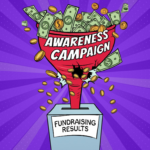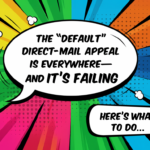What is donor-centered fundraising?
It’s something that fundraising professionals talk about, but not everyone is clear about what it is.
I want to share a definition of the practice from my perspective and opinion.
It’s an approach to fundraising that starts from the assumption that if you want to motivate donors to donate, you need to enter their world.
Donor-centered fundraising is usually seen as an antidote for “organization-centered” fundraising, which uses this approach: “We are an awesome organization, and our cause is very important. Therefore, you should donate to us.”
Judging by my inbox and mailbox, organization-centered fundraising is much more common than donor-centered fundraising. It’s the “default” mode of public fundraising.
It’s also worth pointing out that when you switch from organization-centered to donor-centered fundraising, you will see an immediate and substantial increase in donations. All of us Moceanic Fundraisingologists can attest to that, as can nearly every fundraiser in our members-only community, The Fundraisingology Lab.
The phrase originated from a book, Donor-Centered Fundraising by Penelope Burke, first published in 2003. That book took the audacious step of researching donors. The painful truth it uncovered was that many common fundraising practices were far out of sync with donors.
Donor-centered fundraising was already being practiced before the book came out. But after, we had a name for what it was we were trying to do. And, more important, we had a philosophy that guided our testing and learning.
But, in my opinion, there’s a problem with that name: “donor-centered” as it gives the wrong impression of what we’re doing and why we’re doing it. Fundraising does not exist for donors – however positive giving is in their lives. Fundraising exists to fund our causes.
I’d rather call this approach Donor Love Fundraising.
Because love is the main ingredient. And it’s more than a bunch of tactics and strategies. It’s a mindset that transcends tactics.
Viktor Frankel, in his book Man’s Search for Meaning (which grew out of his experience in Nazi concentration camps; very highly recommended), wrote:
Love is the only way to grasp another human being in the innermost core of his personality.
Another word for charitable giving is philanthropy – from a Greek word meaning love for mankind.
The most effective way to practice donor-centered fundraising is to put love to work in fundraising. Not only love for donors, but also encouraging love from donors.
Here’s what I mean: Jen Shang, a philanthropic psychologist, studies ways to be more effective at fundraising by connecting with psychological realities. She notes that among the main things human beings need for their psychological wellbeing is Connectedness: a genuine sense of satisfying relationships with others.
So it goes beyond doing fundraising that connects well with donors: Things like writing in a way that’s understandable, showing them meaningful action that they understand, and then thanking and reporting back when they give. It goes beyond all those things by helping donors build a sense of genuine love for those their giving helps.
Shang puts it this way:
When people feel connected with others, one human being to another, they can experience psychological wellbeing. They don’t need to be the only person who has power in a relationship in order to experience psychological wellbeing.
A lot of the debate about donor-centered fundraising is not built on an understanding of the psychological wellbeing experienced by the donor. Helping people experience that is both good for them and good for the people that they choose to love.
In other words, a large part of Donor Love fundraising is about encouraging donors to feel and practice love for people they may never be able to meet in person. When that love grows, they are more likely to donate as they are able. Their lives are better. And you get more revenue for your work.
The love someone might feel for someone they’ve only read about or seen photos of is not the same as person-to-person love. But it’s still love. And it can still help change people, and the world.
I’ve heard the objection that when we elevate our love for donors, we decrease or cheapen our love for others who are part of the work we’re doing. Especially those we seek to help and our hardworking staff.
Of course, your clients and your staff do a whole lot more for the cause than do donors who give now and then. That doesn’t mean more love for donors means less for them.
Love doesn’t work that way. It’s endlessly expandable as long as you want to expand it. And love tends to beget love. It grows itself.
An organization that loved its donors and not its clients or staff would be a defective organization indeed. It would be ineffective at its core mission, even if the fundraising was great.
I urge you and your organization to think about Donor Love. It’s a lot more than a path to more revenue. What it means for you is up to you. What you will and will not do to grow love is something you should be conscious about and on the same page about with others in your circle.
You can raise more money from more engaged donors if that’s what you seek. And you can be part of an expanding circle of genuine love.
We’d love to hear what you think and what your experiences have been on this topic.
If you’d like to explore what donor love could mean for you and your organization, join The Fundraisingology Lab by Moceanic. You’ll get the tools, the information, and the supporting community that will take you to new places in your fundraising career. Join the waiting list now and you’ll be the first to hear when the doors open again!
Related Blog Posts:










